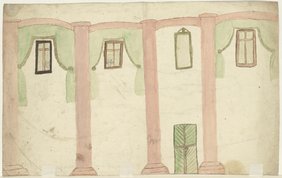It is always possible to come across minor or major surprises among the prints in the Haupt Collection. On the reverse of a rather inconspicuous pen and ink drawing, for example, there is an ink drawing by an obviously younger artist. It depicts a wall of a high, representative hall structured by colossal pilasters, the high windows of which are framed by heavy curtains tied back. As a viewer, one is reminded of a background prospectus of a stage on which various figures are about to appear. Through the window openings, two animals sketched in graphite pencil, a billy goat and a goat, watch the forthcoming spectacle.
Only a few clues to the context of origin can be deduced from the front. It shows a view through a central perspective gateway into a mountainous landscape that is only vaguely indicated. Although it gives the impression of a travel sketch, it is more reminiscent of a study drawing because of the academic-looking central perspective. The collection documentation attests that the drawing was made at the beginning of the 19th century and that it originated in the German-speaking countries. From the point of view of the history of the collection, it is conceivable that it originated at the drawing school of Friedrich Weinbrenner (1766-1826) in Karlsruhe. Sketches on the backs of the surviving exercise sheets repeatedly show childlike caricatures or sketches, which allows socio-historical conclusions to be drawn about the everyday life of these training situations, including the early entry age of the pupils or also parental care situations around 1800 (anyone who has ever looked after children in a home office may perhaps still be able to easily understand this from their own experience today). Possibly, therefore, this drawing testifies to the beginning of a great career of an important 19th century architect.
Simon Paulus


